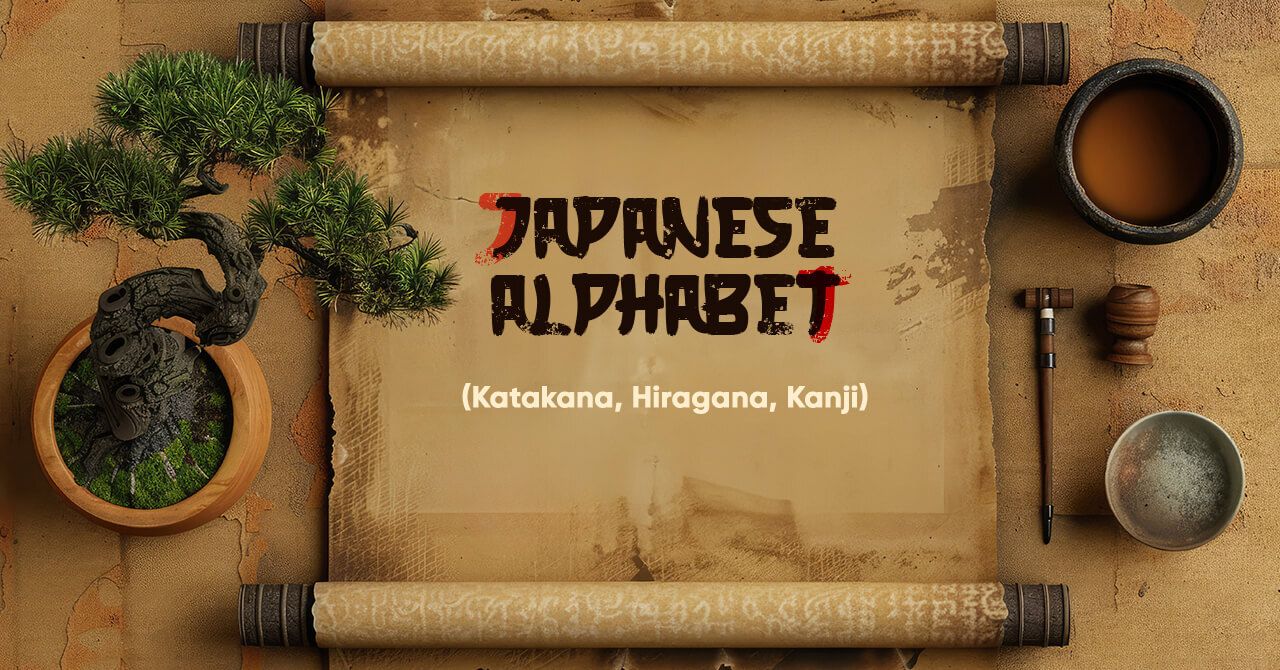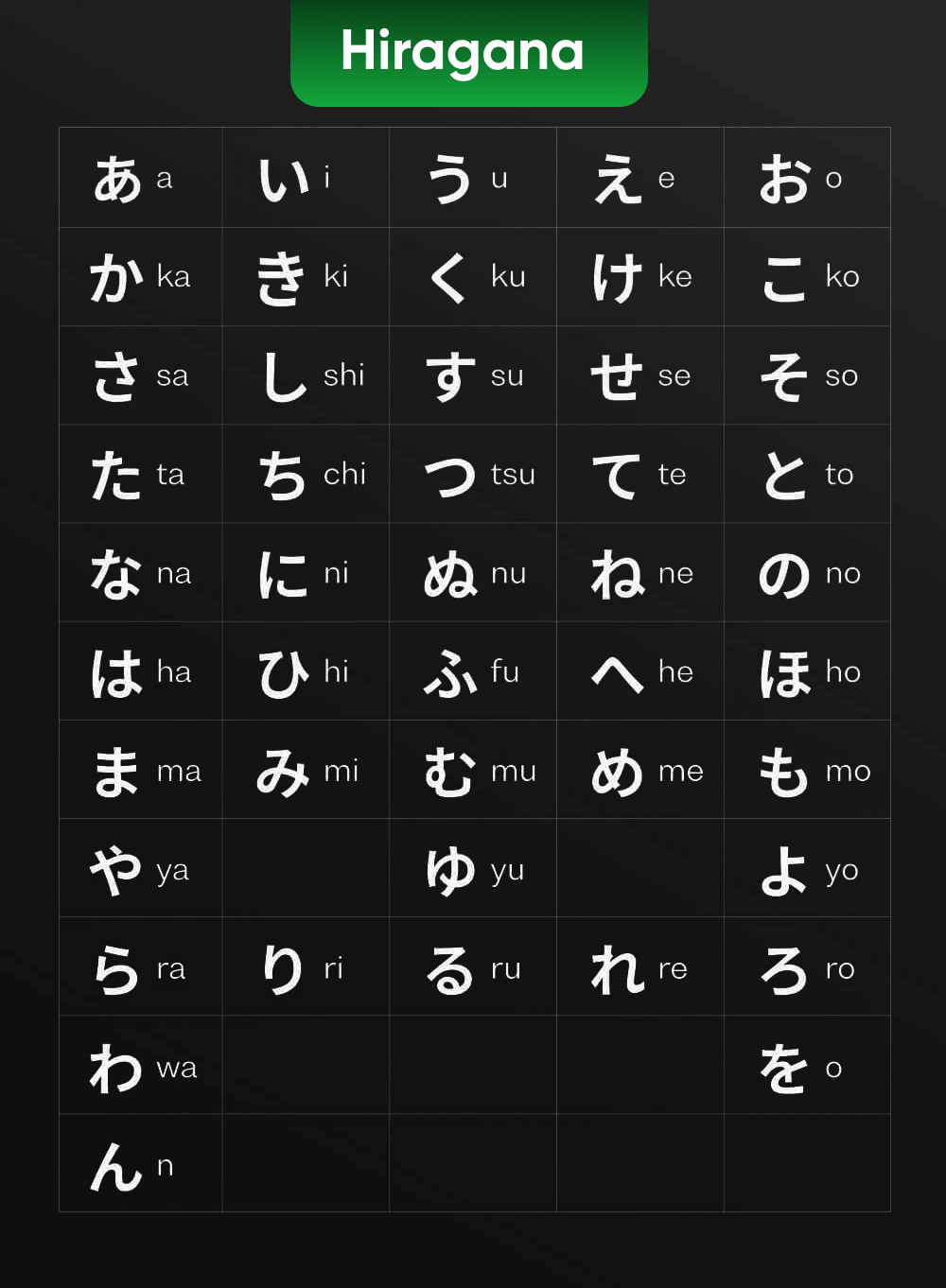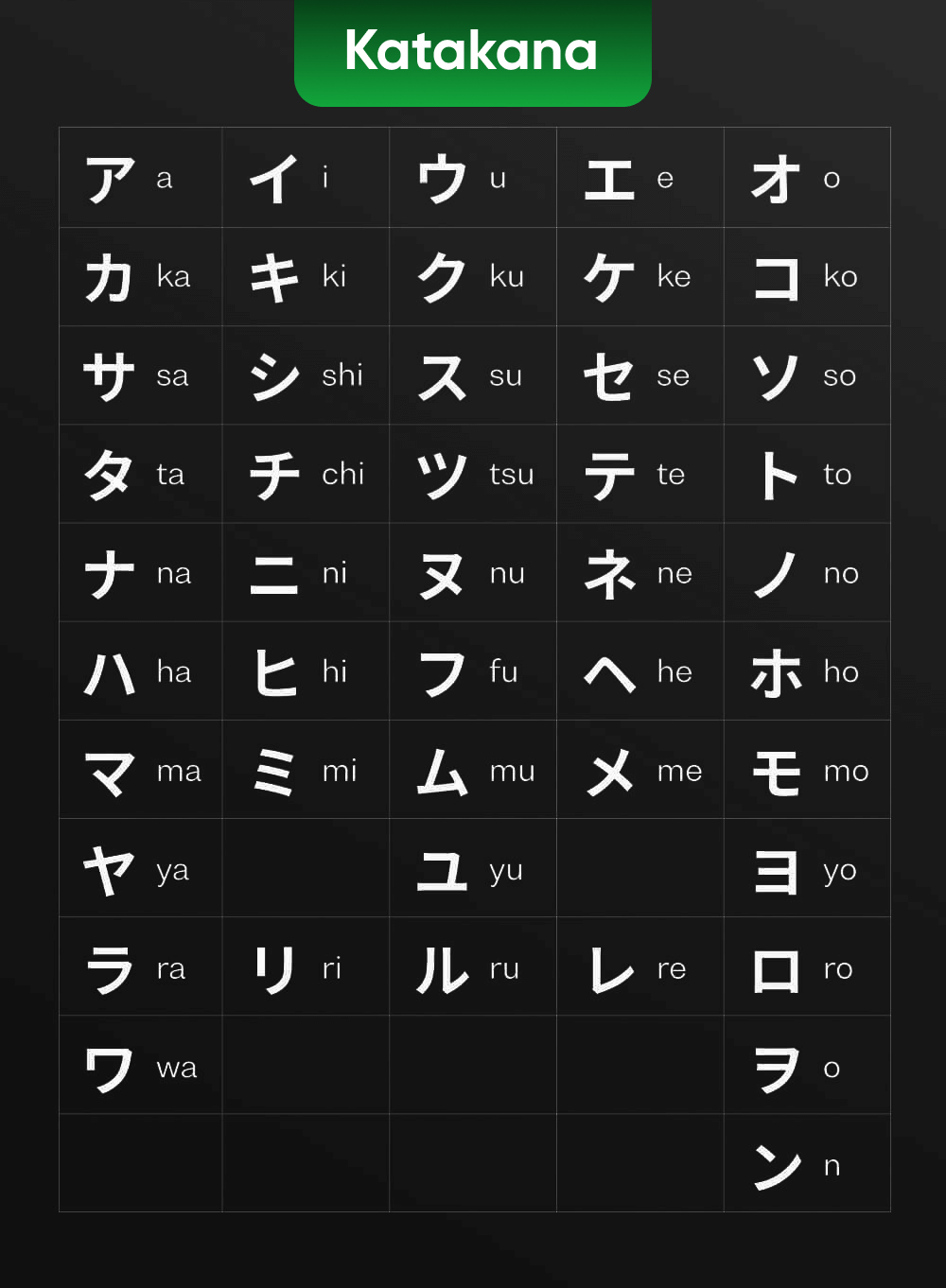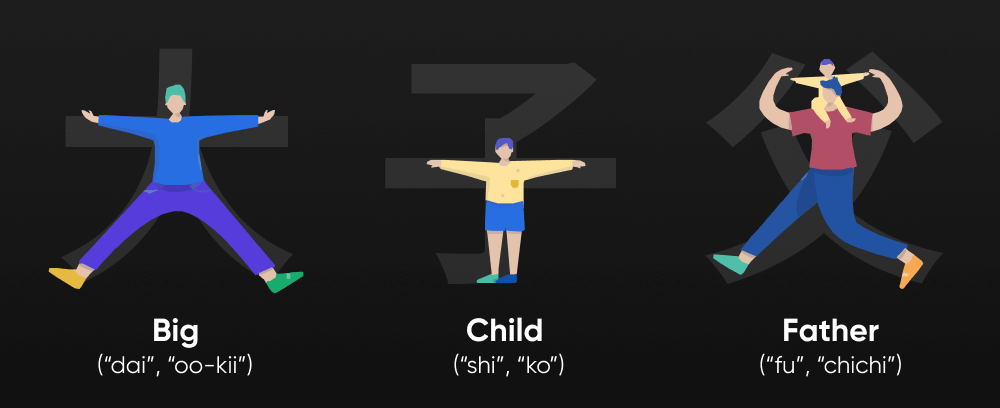Explaining Japanese Alphabet: Katakana, Hiragana & Kanji
Japanese writing consists of three writing systems: Hiragana, Katakana, and Kanji. Every script serves a certain purpose that deepens the language.

Japanese, also called Nihongo (日本語), is spoken by about 123 million people, mainly in Japan. It has a unique and complex writing system made up of three scripts: kanji, hiragana, and katakana. Kanji, borrowed from Chinese, consists of symbols that represent ideas, while hiragana and katakana are simpler, phonetic scripts based on sounds. Hiragana is mostly used for native words and grammar, while katakana is used for foreign words and emphasis. Even though Japanese doesn’t use spaces between words, the combination of these scripts makes written communication clear and expressive. Over time, the language has evolved, strongly influenced by Chinese culture and language. Unlike many Western languages, Japanese follows a subject-object-verb structure and uses small markers called particles to show grammatical relationships. Learning Japanese can be challenging, but its unique writing system makes it a rewarding experience!
What does the Japanese writing system look like?
Japanese writing consists of three writing systems: Hiragana, Katakana, and Kanji. Every script serves a certain purpose that deepens the language.
Hiragana
Hiragana has 46 letters, each representing a different sound in the Japanese language. It is mostly used for the original Japanese vocabulary, grammatical structures, and verb conjugation. For instance, in hiragana, the word “greeting” is written as あいさつ (aisatsu).
Katakana
Also, with 46 letters but more angular forms than hiragana, katakana is also a phonetic syllabary. Mostly used for foreign loanwords, names, scientific phrases, and onomatopoeias. For instance, Katakana writes the word “coffee” as コーヒー(koohii).
Kanji
The entire word or notion is represented by logographic characters taken from Chinese. Kanji is used in nouns, the basic form of verbs and adjectives. The typical literate individual is familiar with around 2,000 Kanji characters. For instance, the term “Japan” is written as 日本 (Nihon).
The Japanese writing system has three functions: kanji shows the main idea, hiragana helps with grammar, and katakana highlights foreign words or emphasizes a point. Mixing them makes the language clear and expressive.
Hiragana: an interpretive guide
Hiragana (ひらがな) is one of the three primary writing systems in Japanese, alongside katakana and kanji. There are 46 letters in it, all with a different syllable or pronunciation. Unlike the katakana’s acute angles, hiragana is seen as softer-looking as its cursive form flows.

What is hiragana used for?
Hiragana is mainly used for native Japanese words, grammar, and small function words. It often appears in suffixes after kanji, helping to form verb and adjective endings. For example, the verb “to see” (見る) changes its form using hiragana.
Learning hiragana
Learning Japanese phonetics often starts with learning the five vowel sounds: あ (a), い (i), う (u), え (e), and お (o). Together with consonants, these vowels create extra syllables such as か (ka) and さ (sa). By doubling vowel sounds, hiragana may even symbolize lengthy vowels—that is, “mother,” which is written as おかあさん (okaasan). Though it is far more usually coupled with kanji for clarity and depth of meaning, it is also feasible to write full sentences alone in hiragana. Generally speaking, hiragana is the fundamental building component guiding the understanding of the grammar and pronunciation of the Japanese language.
Katakana: an interpretive guide
Katakana (カタカナ) has 46 basic characters, each representing a syllable or sound. Unlike the rounded shapes of Hiragana, Katakana is known for its sharp and angular letters.

What is katakana used for?
Katakana mostly consists of foreign loanwords, names, and scientific phrases. For instance, Katakana writes the English word “computer” as コンピュータ(konpyuuta).
Learning katakana
Usually, after the study of hiragana, katakana completes the grasp of the Japanese language. Like hiragana, it features five vowel sounds: ア(a), イ(i), ウ(u), エ(e), オ(o), which, when mixed with consonants, create syllables like カ (ka) and サ (sa).
Katakana is often used for emphasis in writing, similar to italics in English. It helps show emotion, highlight accents, or make certain words stand out. While katakana can be used alone, it’s usually mixed with kanji and hiragana for better understanding. To read and write Japanese fluently, knowing katakana is essential!
Dakken and handakuten
In the Japanese writing system, dakuten (濁点) and handakuten (半濁点) are a kind of diacritical mark used to denote changes in the pronunciation of the kana letter. Stated differently, one must grasp phonetic complexity in Japanese language usage.
What is dakuten?
With two little strokes resembling quotation marks, dakuten is placed on the top right of a kana character. It suggests vocalizing the consonant sound. Adding dakuten to か (ka) transforms it to が (ga), for instance. Further consonants and their variations are as follows:
- さ (sa) to ざ (za)
- た (ta) to だ (da)
- は (ha) to ば (ba)
There are exceptions, such as し (shi), which becomes じ (ji), and ち (chi), which becomes ぢ (ji).
What is handakuten?
Written at the top right of a kana character, handakuten is a little circle. This suggests a voiceless bilabial plosive; all “h” sounds become “p.” For instance: は (ha) becomes ぱ (pa).
Dakuten and handakuten are small marks that change how hiragana and katakana sound, helping to cover all the pronunciations in Japanese. Knowing these marks is key to pronouncing words correctly and understanding written Japanese.
When to use katakana and hiragana
Being part of the Japanese writing system, both katakana and hiragana have various functions when used.
When to use hiragana?
Japanese native words, grammatical components, and function words mostly make use of Hiragana. It finds use in the following settings:
- Grammatical elements: Hiragana provides the necessary grammatical structure to sentences by means of particle representations—that is, for example, は, が, をand verb conjugations.
- Words without kanji: Hiragana is used to write common words that don’t have kanji or when kanji isn’t needed. For instance, “hello” is こんにちは (konnichiwa).
- Pronunciation: Hiragana characters help youngsters and learners by indicating pronunciation when put next to kanji.
Put simply, the foundation of Japanese grammar and daily language is hiragana.
When to use katakana?
Conversely, katakana is mostly used for foreign loanwords and certain artistic purposes:
- Loanwords: Usually written in katakana, words taken from other languages—especially English—are spelled in katakana. For instance, “computer” becomes コンピュータ (konpyūta).
- Symbolizing sound: Like dogs’ barking, katakana is used to symbolize sounds or words replicating sounds.
- Emphasizing a word or phrase or as a stylistic device: Katakana can be thought of as similar to italics used in English.
In essence, katakana is used for foreign words and some particular phrases; hiragana is used for native language parts and grammar. Knowing when to use which script maintains clarity and comprehension inside the text written in Japanese.
Kanji: an interpretive guide
Important components of the Japanese writing system, kanji, often known as “informational characters,” are logographic Chinese letters taken from originally employed in the fifth century, kanji represent most content words—including adjectives, verb stems, and nouns. To become literate in Japan, one must know around 2,136 often-used kanji characters, also referred to as jōyō kanji.
Kanji’s examples include:
- 日 – hi (day, sun)
- 月 – tsuki (moon, month)
- 山 – yama (mountain)
- 水 – mizu (water)
- 金 – kin (gold, money)
These characters often have multiple readings: an on’yomi (Chinese reading) and a kun’yomi (Japanese reading). For instance, the Kanji for “mountain” can be read as yama (Japanese reading) or san (Chinese reading).
Kanji becomes a serious stumbling block for learners. These characters are not sounds that you put together to get a word. Kanji represents whole words or ideas. There are over 6,000 kanji characters, which makes it almost impossible to learn them all. However, you do not need to! Mastering at least 1,000 of them will allow you to understand about 95% of written Japanese content. Imagination comes in handy here if your visual memory is dominated. Just look:

When to use kanji
Kanji is mainly used for nouns, verb and adjective roots, and adverbs, making written Japanese clearer and more precise. While hiragana and katakana can represent all sounds in the language, they don’t carry as much meaning as kanji.
Knowing just hiragana and katakana isn’t enough for writing in Japanese. You can have basic conversations without kanji, but things like newspapers, books, and signs can be hard to understand without it. If you’re serious about learning Japanese, mastering all three writing systems is a must!
Romanji: an interpretive guide
Romaji is the romanization of the Japanese language, in which case the Latin alphabet is used to depict Japanese sounds. Designed to assist non-Japanese speakers in reading and speaking Japanese without learning its original letters, Hiragana, Katakana, and Kanji, this system “Romaji” literally means “Roman letters.”
Romaji’s goals are for:
- Language studying: For beginners studying Japanese, it provides a readily available starting point as it lets them pick up phonetics and pronunciation before inevitably acquiring sophisticated writing systems.
- International communication: To help visitors and foreigners negotiate their way around Japan a little more simply, this is frequently utilized in travel-related situations such as road signs, airport signage, and international business paperwork.
- Typing and technology: When the computer or gadget does not accept Japanese characters, Japanese text has been typed using other languages. Users would enter words using their phonetic pronunciation.
Romaji is useful for beginning, but it is by no means the complete and end-all needed for literacy in Japanese. Learners must finally study Hiragana, Katakana, and Kanji if they want more usage of the language, culture, and literature. Learning the writing systems will help students to grasp Japanese in terms of expression and communication.
How to learn Japanese alphabet
Studying individually with the instructors on LiveXP offers numerous benefits, and learning Japanese can be a rather fulfilling journey. This platform links students with perfect-match Japanese tutors online for customized, one-on-one education catered to specific requirements.
Free schedule
On LiveXP, it’s up to you to decide when it’s best for you to have lessons (unlike language schools). Whether it is at night time or early morning, you will be able to find a Japanese tutor who will teach you at this time. Having the LiveXP allows you to practice anytime and anywhere.
Tutor’s attention is focused on you
In a private environment, your tutor’s whole attention is yours; therefore, quick comments. In a language like Japanese where often one mispronunciation may completely alter the meaning, such real-time correction can help you avoid reinforcing errors—something rather crucial. Your instructor may also offer insight into cultural subtleties that can improve your language comprehension.
Word Trainer for expanding your vocabulary
With the LiveXP app, specifically the Word Trainer feature, you can learn and practice new words and phrases with a spaced repetition algorithm anywhere on your smartphone. Spaced repetition ensures that you learn a specific word at a specific time interval to put it in long-term memory and use your vocabulary actively.
Learning Japanese from a private instructor on LiveXP overall implies tailored lessons with the ease of online courses, which is a good approach to reaching fluency and confidence in the language.
Conclusion
Three forms of writing—hiragana, katakana, and kanji—form the rich, sophisticated Japanese writing system. From native idioms to foreign terminology, each has a particular use. Understanding fluency and literacy requires these fundamental elements. Moreover, the Romaji does not replace learning the native Japanese letters; rather, the Romaji gives an excellent lead for novices to readily grasp the pronunciation.
For successful study of Japanese, private coaching can be highly useful. On LiveXP, for instance, one will be able to get direct and personal tutors applying individualized teaching approaches based on the needs of the student. Customized courses provide feedback right away and deeper in linguistic complexity.Japanese

I am a native Chinese speaker. I also know two foreign languages (English and Japanese are among them). I am here to share my experience.



